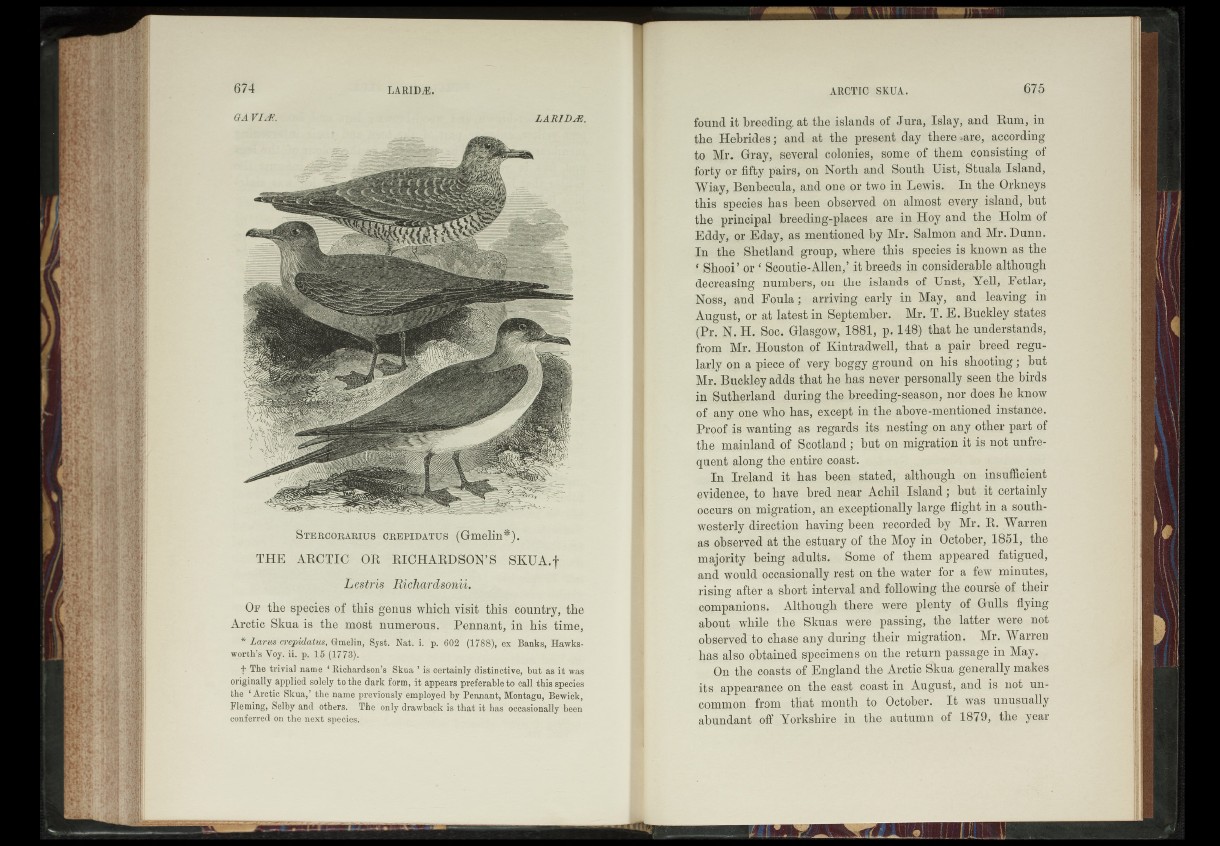
Stercorarius- orepidatuB ‘(Gmelin*).
THE A R C T IC OB jBTCHARDSON’S ^ SKUA.f
bestri's btickardsonii.
■ Of thefspecies of this genus which vMt this' country, the
Arctic Skua is thei most numerous.1 Pennant,'ih his time,
* Larm crepidatus, Gmelin,- 45jst. ]^a^3^)p.'602'..{B8,8)y'r‘6x Banks, Hawks -
worth’s Voy. 15 ,(177®),- ,
t-The trivial namg ‘ Richardson’s Skpa ’ is certainly distinctive,- it was
originally applied solely,to the. dark form, it appears preferable to call this species
the ‘ Arctic Skua,’ the name previously employed by Pennant, Montagu, Bewick,
Fleming, Selby ’and others. - Tffe only drawback-is-that it has occasionally been
conferred on the next speeies^ .
found it breeding, at the islands of Jura, Islay, and Rum, in
the Hebrides ; and . at the present day there «are, according
to Mr. Gray, several colonies, spin© .of thejn consisting of
forty or fifty pairs, on North and South TJist, Stuala Island,
Wiay, Renhecplft, and one or twp in Hewis- In the Orkneys
this species has been pbsprved op almost every' island, but
the principal breeding*phices are in Hoy and the Holnj of
Eddy,: pr Eday, as mentioned by Mr. Salmon and Mr. Dunn.
In the Shetland group, where this species is known as the
| Shoe!’ or I Scoufie-Allen,’ it breeds in considerable although
decreasing numbers, ph |he islands of Unst, Yell',. Fptlar,
#nd Foula; arriving eaHy in and-leaving in
August, or at latest in September., Mr. T. E. Buckley states
(Pr. N* H, Sec. Glasgow, 1881, p. 148) that he understands,
from My. Houston pf Kintradwell, that a pair, breed regularly
on piece, pf very, boggy ground on his shqotingj but
Mr. Hnpkley adds that he has never personally seen -the biyds
in Sutherland during ,the breeding-season, nqr does he know
of any one who has, except in the ftboye-rp.entioned instance.
Proof is wanting as regards its nesting on apy other part of
the mainland of Scotland ; but on migration it is not unfre-
(|nent along the entire coast* *
In Ireland;,it has bee% stated, gtthpUgh. on insufleient
evidence, to have hred near Achilleland; but it .certainly
occurs’ pn migration, an exceptionally large flight in a southwesterly
direction having been recorded by Mr. R. Warren
as observed at the estuary of the Moy in October, 1851-, the
majority being adults,. • - JSpnae of them appeared fatigued,
and A^ould occasionally rest cm the water a few minut^,
riging after a short interyal andfoliowing the course of their
copipanions. .-Although there were plenty of( Ophs Ayhig
about while -the- Skuas were passing, the latter were ..no-t
observed-to .chase any during-, their, migration. Mr. barren
has also .obtained specimens pn the return passage in May. f .
On the coasts of England the Ayeta^Skua generally makes
ifs appearance on the Aea&t coast in. August, and jjlu o t .uncommon
from that month „tp /Oct^htey. If Wa3 anusjjally
abundant off Yorkshire in ^the auth^^l^f- 1879, the year